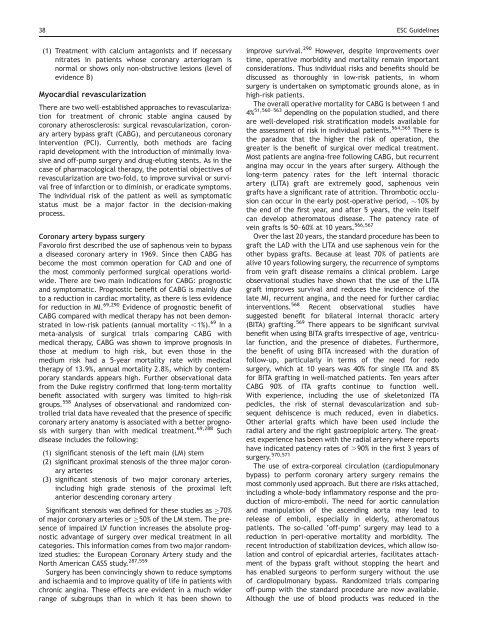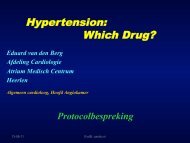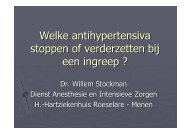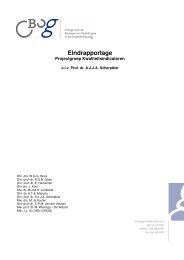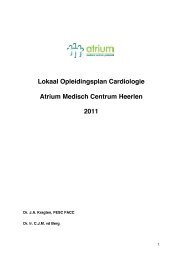Guidelines on the Management of Stable Angina Pectoris ... - Cardio
Guidelines on the Management of Stable Angina Pectoris ... - Cardio
Guidelines on the Management of Stable Angina Pectoris ... - Cardio
Create successful ePaper yourself
Turn your PDF publications into a flip-book with our unique Google optimized e-Paper software.
38 ESC <str<strong>on</strong>g>Guidelines</str<strong>on</strong>g>(1) Treatment with calcium antag<strong>on</strong>ists and if necessarynitrates in patients whose cor<strong>on</strong>ary arteriogram isnormal or shows <strong>on</strong>ly n<strong>on</strong>-obstructive lesi<strong>on</strong>s (level <strong>of</strong>evidence B)Myocardial revascularizati<strong>on</strong>There are two well-established approaches to revascularizati<strong>on</strong>for treatment <strong>of</strong> chr<strong>on</strong>ic stable angina caused bycor<strong>on</strong>ary a<strong>the</strong>rosclerosis: surgical revascularizati<strong>on</strong>, cor<strong>on</strong>aryartery bypass graft (CABG), and percutaneous cor<strong>on</strong>aryinterventi<strong>on</strong> (PCI). Currently, both methods are facingrapid development with <strong>the</strong> introducti<strong>on</strong> <strong>of</strong> minimally invasiveand <strong>of</strong>f-pump surgery and drug-eluting stents. As in <strong>the</strong>case <strong>of</strong> pharmacological <strong>the</strong>rapy, <strong>the</strong> potential objectives <strong>of</strong>revascularizati<strong>on</strong> are two-fold, to improve survival or survivalfree <strong>of</strong> infarcti<strong>on</strong> or to diminish, or eradicate symptoms.The individual risk <strong>of</strong> <strong>the</strong> patient as well as symptomaticstatus must be a major factor in <strong>the</strong> decisi<strong>on</strong>-makingprocess.Cor<strong>on</strong>ary artery bypass surgeryFavorolo first described <strong>the</strong> use <strong>of</strong> saphenous vein to bypassa diseased cor<strong>on</strong>ary artery in 1969. Since <strong>the</strong>n CABG hasbecome <strong>the</strong> most comm<strong>on</strong> operati<strong>on</strong> for CAD and <strong>on</strong>e <strong>of</strong><strong>the</strong> most comm<strong>on</strong>ly performed surgical operati<strong>on</strong>s worldwide.There are two main indicati<strong>on</strong>s for CABG: prognosticand symptomatic. Prognostic benefit <strong>of</strong> CABG is mainly dueto a reducti<strong>on</strong> in cardiac mortality, as <strong>the</strong>re is less evidencefor reducti<strong>on</strong> in MI. 69,290 Evidence <strong>of</strong> prognostic benefit <strong>of</strong>CABG compared with medical <strong>the</strong>rapy has not been dem<strong>on</strong>stratedin low-risk patients (annual mortality ,1%). 69 In ameta-analysis <strong>of</strong> surgical trials comparing CABG withmedical <strong>the</strong>rapy, CABG was shown to improve prognosis inthose at medium to high risk, but even those in <strong>the</strong>medium risk had a 5-year mortality rate with medical<strong>the</strong>rapy <strong>of</strong> 13.9%, annual mortality 2.8%, which by c<strong>on</strong>temporarystandards appears high. Fur<strong>the</strong>r observati<strong>on</strong>al datafrom <strong>the</strong> Duke registry c<strong>on</strong>firmed that l<strong>on</strong>g-term mortalitybenefit associated with surgery was limited to high-riskgroups. 558 Analyses <strong>of</strong> observati<strong>on</strong>al and randomized c<strong>on</strong>trolledtrial data have revealed that <strong>the</strong> presence <strong>of</strong> specificcor<strong>on</strong>ary artery anatomy is associated with a better prognosiswith surgery than with medical treatment. 69,288 Suchdisease includes <strong>the</strong> following:(1) significant stenosis <strong>of</strong> <strong>the</strong> left main (LM) stem(2) significant proximal stenosis <strong>of</strong> <strong>the</strong> three major cor<strong>on</strong>aryarteries(3) significant stenosis <strong>of</strong> two major cor<strong>on</strong>ary arteries,including high grade stenosis <strong>of</strong> <strong>the</strong> proximal leftanterior descending cor<strong>on</strong>ary arterySignificant stenosis was defined for <strong>the</strong>se studies as 70%<strong>of</strong> major cor<strong>on</strong>ary arteries or 50% <strong>of</strong> <strong>the</strong> LM stem. The presence<strong>of</strong> impaired LV functi<strong>on</strong> increases <strong>the</strong> absolute prognosticadvantage <strong>of</strong> surgery over medical treatment in allcategories. This informati<strong>on</strong> comes from two major randomizedstudies: <strong>the</strong> European Cor<strong>on</strong>ary Artery study and <strong>the</strong>North American CASS study. 287,559Surgery has been c<strong>on</strong>vincingly shown to reduce symptomsand ischaemia and to improve quality <strong>of</strong> life in patients withchr<strong>on</strong>ic angina. These effects are evident in a much widerrange <strong>of</strong> subgroups than in which it has been shown toimprove survival. 290 However, despite improvements overtime, operative morbidity and mortality remain importantc<strong>on</strong>siderati<strong>on</strong>s. Thus individual risks and benefits should bediscussed as thoroughly in low-risk patients, in whomsurgery is undertaken <strong>on</strong> symptomatic grounds al<strong>on</strong>e, as inhigh-risk patients.The overall operative mortality for CABG is between 1 and4% 51,560–563 depending <strong>on</strong> <strong>the</strong> populati<strong>on</strong> studied, and <strong>the</strong>reare well-developed risk stratificati<strong>on</strong> models available for<strong>the</strong> assessment <strong>of</strong> risk in individual patients. 564,565 There is<strong>the</strong> paradox that <strong>the</strong> higher <strong>the</strong> risk <strong>of</strong> operati<strong>on</strong>, <strong>the</strong>greater is <strong>the</strong> benefit <strong>of</strong> surgical over medical treatment.Most patients are angina-free following CABG, but recurrentangina may occur in <strong>the</strong> years after surgery. Although <strong>the</strong>l<strong>on</strong>g-term patency rates for <strong>the</strong> left internal thoracicartery (LITA) graft are extremely good, saphenous veingrafts have a significant rate <strong>of</strong> attriti<strong>on</strong>. Thrombotic occlusi<strong>on</strong>can occur in <strong>the</strong> early post-operative period, 10% by<strong>the</strong> end <strong>of</strong> <strong>the</strong> first year, and after 5 years, <strong>the</strong> vein itselfcan develop a<strong>the</strong>romatous disease. The patency rate <strong>of</strong>vein grafts is 50–60% at 10 years. 566,567Over <strong>the</strong> last 20 years, <strong>the</strong> standard procedure has been tograft <strong>the</strong> LAD with <strong>the</strong> LITA and use saphenous vein for <strong>the</strong>o<strong>the</strong>r bypass grafts. Because at least 70% <strong>of</strong> patients arealive 10 years following surgery, <strong>the</strong> recurrence <strong>of</strong> symptomsfrom vein graft disease remains a clinical problem. Largeobservati<strong>on</strong>al studies have shown that <strong>the</strong> use <strong>of</strong> <strong>the</strong> LITAgraft improves survival and reduces <strong>the</strong> incidence <strong>of</strong> <strong>the</strong>late MI, recurrent angina, and <strong>the</strong> need for fur<strong>the</strong>r cardiacinterventi<strong>on</strong>s. 568 Recent observati<strong>on</strong>al studies havesuggested benefit for bilateral internal thoracic artery(BITA) grafting. 569 There appears to be significant survivalbenefit when using BITA grafts irrespective <strong>of</strong> age, ventricularfuncti<strong>on</strong>, and <strong>the</strong> presence <strong>of</strong> diabetes. Fur<strong>the</strong>rmore,<strong>the</strong> benefit <strong>of</strong> using BITA increased with <strong>the</strong> durati<strong>on</strong> <strong>of</strong>follow-up, particularly in terms <strong>of</strong> <strong>the</strong> need for redosurgery, which at 10 years was 40% for single ITA and 8%for BITA grafting in well-matched patients. Ten years afterCABG 90% <strong>of</strong> ITA grafts c<strong>on</strong>tinue to functi<strong>on</strong> well.With experience, including <strong>the</strong> use <strong>of</strong> skelet<strong>on</strong>ized ITApedicles, <strong>the</strong> risk <strong>of</strong> sternal devascularizati<strong>on</strong> and subsequentdehiscence is much reduced, even in diabetics.O<strong>the</strong>r arterial grafts which have been used include <strong>the</strong>radial artery and <strong>the</strong> right gastroepiploic artery. The greatestexperience has been with <strong>the</strong> radial artery where reportshave indicated patency rates <strong>of</strong> .90% in <strong>the</strong> first 3 years <strong>of</strong>surgery. 570,571The use <strong>of</strong> extra-corporeal circulati<strong>on</strong> (cardiopulm<strong>on</strong>arybypass) to perform cor<strong>on</strong>ary artery surgery remains <strong>the</strong>most comm<strong>on</strong>ly used approach. But <strong>the</strong>re are risks attached,including a whole-body inflammatory resp<strong>on</strong>se and <strong>the</strong> producti<strong>on</strong><strong>of</strong> micro-emboli. The need for aortic cannulati<strong>on</strong>and manipulati<strong>on</strong> <strong>of</strong> <strong>the</strong> ascending aorta may lead torelease <strong>of</strong> emboli, especially in elderly, a<strong>the</strong>romatouspatients. The so-called ‘<strong>of</strong>f-pump’ surgery may lead to areducti<strong>on</strong> in peri-operative mortality and morbidity. Therecent introducti<strong>on</strong> <strong>of</strong> stabilizati<strong>on</strong> devices, which allow isolati<strong>on</strong>and c<strong>on</strong>trol <strong>of</strong> epicardial arteries, facilitates attachment<strong>of</strong> <strong>the</strong> bypass graft without stopping <strong>the</strong> heart andhas enabled surge<strong>on</strong>s to perform surgery without <strong>the</strong> use<strong>of</strong> cardiopulm<strong>on</strong>ary bypass. Randomized trials comparing<strong>of</strong>f-pump with <strong>the</strong> standard procedure are now available.Although <strong>the</strong> use <strong>of</strong> blood products was reduced in <strong>the</strong>


